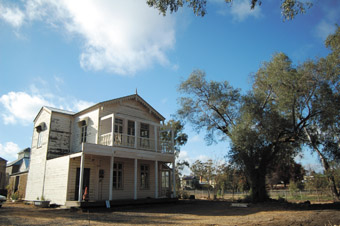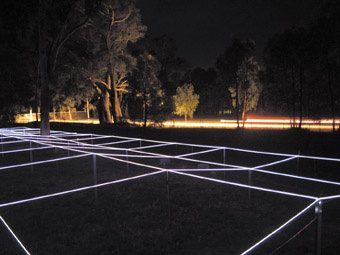images of resilience
nicolas low sees jane prophet light the avoca project

The Avoca Project
photo Nicolas Low
The Avoca Project
AVOCA IS A SMALL PLACE. ONE MAIN STREET, 20 SHOPS, 40 PACES, BLINK, AND IT’S GONE. THE TOWN IS AMONG THE 25 POOREST IN THE STATE OF VICTORIA AND THE TRUCKS THAT ROLL IN TEND TO ROLL OUT AGAIN WITHOUT STOPPING. THERE HAVE BEEN SOME CHANGES IN RECENT YEARS AND, WITH AN INFLUX OF VINEYARDS AND WINE BARS, THE POPULATION IS CHANGING. BUT WHEN I ASKED THE MAN AT THE LOCAL GARAGE IF HE WAS BORN AND BRED IN THE REGION HE JUST LAUGHED. “ONLY BEEN HERE 20 YEARS, MATE. NOT LONG ENOUGH TO BE A LOCAL IN AVOCA.” TWENTY YEARS, AND STILL AN IMMIGRANT.
Unlikely as it may seem, Avoca is the site of senior Australian artist Lyndal Jones’ latest major work. Centred around an ‘immigrant house’, a beautiful, paint-peeling weatherboard hotel brought out from Germany in the 1850s, Jones has undertaken a 10-year project with the Avoca community, international artists, sustainability experts and writers to develop the house as “a poetic image of resilience.” It’s a long-term investigation into art, place and climate change in relationship to Australia’s immigrant communities, with Jones and her resident artists, the first of whom is the UK’s Jane Prophet, slowly charting the house’s integration into a small country town.
When you set out to create any major artwork there’s a lot of practical groundwork to be done. For the Avoca Project this has been literal: replacing the house’s ancient, rotted foundations. This ostensibly practical task is for Jones an integral part of the artwork, speaking of the harshness of our environment and the resilience of the immigrant in the face of radical change. The main body of work to date has thus been a series of long-term processes of “mending the house” incorporating video documentation, simple performances, landscaping and superhuman acts of renovation.

Jane Prophet, Counterbalance, The Avoca Project
photo Nicolas Low
Jane Prophet, Counterbalance, The Avoca Project
There’s also been groundwork to do in convincing people that a house can in fact be a work of art. Art in Avoca previously came in the form of painter and gallery owner Laurie McMurray, whose grey-bearded countenance fits with ideas of what an artist is and does. For Lyndal Jones, working in Avoca has meant spending time simply getting to know locals and building a context in which to work. She has been meticulous in her courtesies, dropping meals off to a sick neighbour, telling people about the work as it progresses, paying her respects despite the fact that the local tradesmen weren’t initially receptive to working for an outsider. Even to some in the city of Melbourne, the project reportedly looks like a budding arts centre or residency program, or worse still, a holiday house. “It’s not an arts centre,” insists Jones. “The house itself, and the processes which surround it over a 10-year period are the work.” It’s an ambitious concept in our real-estate-obsessed times, which equates houses with investments. Jones is instead turning our attention to the life of a house, its history and stories.
It took three years to get this dwelling to a habitable state and, once that was done, the doors opened in November 2007 for Avoca’s newest immigrant, London’s Jane Prophet. In Australia as the inaugural RMIT Creative Media Artist in Residence, Prophet’s a bright-eyed, razor-sharp woman who doesn’t wear her experience on her sleeve. But behind the hilarious anecdotes is a wealth of experience running projects like Technosphere, a multi-user online ecosystem which won her and her collaborators second prize in the Prix Ars Electronica in 1997. Her more recent work in the UK continues a long-held fascination with landscape and artifice, making her an ideal inaugural resident.
For Counterbalance, Prophet created a 12m by 8m stepped grid of electroluminescent light cable. The three levels of the grid are positioned to represent the water levels of three huge floods in the last century. To provide structure for the installation, Prophet used star pickets, a common farming material. By day it looked like the bizarre fencing project of an obsessive-compulsive. At dusk however, when the cable began to glow a fierce bluish white, the installation appeared as an abstract plane of light hovering above the grounds of the house. Designed to be seen by night from the road (and specifically from passing utes) it was a kind of 3D wireframe graph rendered in real life, conjuring the enormous bodies of water that have previously drowned the house.
Floods are part of both Avoca’s and the house’s mythology and in the two months I spent there as writer in residence, numerous people related flood stories. The waters came up to the back steps of the Avoca Hotel. Two foot high over the ticket box at the local sports ground. “Half-way up the kitchen walls and all this work I’m doing’ll be fucked when it happens again,” said a builder working on the house, an evil glint in his eye. Prophet latched onto these stories as the basis for her installation, constructing the grid as both visual reference and conversational anchor point.
In creating Counterbalance, Prophet faced plenty of physical challenges. But being an immigrant, perhaps her biggest challenge was gauging her audience. Avoca is a fiercely utilitarian place and isn’t big on over-opinionated art-savvy types. As a result there was a tangible sense of uncertainty towards the piece. Prophet was caught between the need for her audiences to have an intimate knowledge of local history, the house and the floods, but also familiarity with the visual language of installation. Plenty commented on the beauty of the form itself and there was constant foot traffic past the house, but many others would not be drawn to express an opinion.
On its own, Counterbalance might have been open to the charge from die-hard community cultural development types that it didn’t speak a sufficiently accessible visual language. But it would be disingenuous to read the work in this light. Counterbalance stood on its own as a beautiful, meticulously crafted work of light installation, and its basis in the rich mythology of the floods provided a clear point of entry. What’s more, those gaps between immigrant and local are at the heart of the Avoca project. Counterbalance forms one element of Lyndal Jones’ much larger, long-term project, and is the first step in laying out this relationship for scrutiny and critique.
Jane Prophet, Counterbalance, The Avoca Project, Avoca, Victoria
Nov 8, 2007-Jan 14, 2008, www.janeprophet.com/avoca_web, www.avocaproject.org
RealTime issue #83 Feb-March 2008 pg. 29






